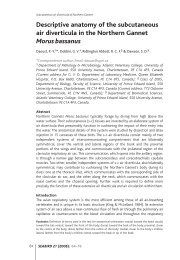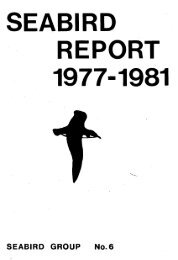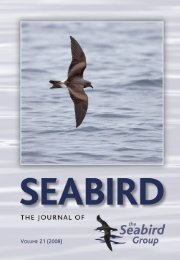Create successful ePaper yourself
Turn your PDF publications into a flip-book with our unique Google optimized e-Paper software.
2001 <strong>Seabird</strong>s on Ascension 187<br />
THE DISTRIBUTION AND BREEDING SUCCESS OF<br />
SEABIRDS ON AND AROUND ASCENSION IN THE<br />
TROPICAL ATLANTIC OCEAN<br />
W.R.P. BOURNE 1 & K.E.L. SIMMONS 2<br />
Bourne W.R.P. & Simmons K.E.L. 2001. <strong>The</strong> distribution and breeding success of<br />
seabirds on and around Ascension in the tropical Atlantic Ocean. Atlantic <strong>Seabird</strong>s 3(4):<br />
187-202. Ascension was once one of the greatest seabird colonies in the world,<br />
comparable to the largest in the Pacific and Indian Oceans, the only one in the<br />
apparently barren centre of the tropical South Atlantic. <strong>The</strong> birds have been reduced by<br />
introduced rats and cats over the last three centuries, but early accounts, guano and<br />
bones suggest there were once more, most breeding in the north of the island.<br />
Observations from the shore and at sea indicate that while some seabirds may feed<br />
offshore and in an area of marine turbulence in the lee of the island to the west, many<br />
fly north towards the Equatorial Counter-current, where there are many more birds and<br />
cetaceans than to the south. Periodically there is increased rainfall which may be<br />
accompanied by seabird breeding failures, as in 1876, 1924, 1958-59, 1963, 1991-92<br />
and 1997, possibly associated with fluctuations in the counter-current, similar to, but<br />
not always simultaneous with, El �iño-Southern Oscillation (E�SO) events elsewhere.<br />
<strong>The</strong>re is a need for world-wide monitoring and attention to the implications of these<br />
fluctuations.<br />
1 Department of Zoology, Aberdeeen University, Tilydrome Avenue, Aberdeen AB24<br />
2TZ, U.K. 2 66 Romway Road, Leicester LE5 5SB, U.K.<br />
"We steered away SSE and SSE half East until in the Lat. of 7 deg. 50. min. we met with<br />
many Ripplings in the Sea like a Tide or strong Current, which setting against the wind<br />
caused such a rippling. We continued to meet these Currents from that Lat. until we<br />
came into the Lat. of 3 deg. 22 �. when they ceased. During this time we saw some<br />
Boneta's and Sharks; catching one of these."<br />
William Dampier (1703)<br />
INTRODUCTION<br />
Ascension is a recent volcanic island some 10 km in diameter lying at 07°57'S<br />
14°22'W, nearly 500 nautical miles south of the Equator in the central tropical<br />
Atlantic (Figs. 1, 2). Its climate is usually dry, with local orographic condensation<br />
where the prevailing SE trade-winds strike 500 m Green Mountain in the<br />
east, and with torrential rain mainly in March and April at irregular intervals of<br />
several years. It originally had a poor flora and terrestrial fauna, now reinforced<br />
by introductions, but when first discovered in 1501 many breeding seabirds








